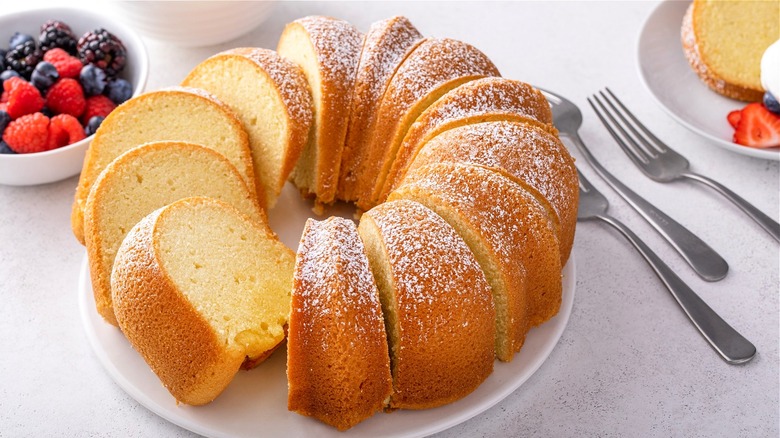Here's How Pound Cake Got Its Name
Who doesn't enjoy indulging in a big slice of homemade cake every now and then? When you think of the classic confection, you probably picture a nice springy round dessert entrenched with decadent icing between fluffy layers. Yet, the classic layer cake you know and love has come a long way since humans began baking cakes thousands of years ago.
If you ever wondered how cake became a classic birthday emblem, the Colombia Daily Tribune claims Egyptians founded the tradition by forming and illuminating round cakes with candles in honor of Artemis, goddess of the moon.
As far as other foundational roots of popular cakes, German chocolate cake actually has no German heritage at all. In fact, the cake acquired its title from a man named Sam German, who developed a bar of chocolate for the Baker's chocolate company and one home chef in 1957 made an award-winning cake using the confection (via NPR).
While sponge cake took many different forms throughout history, What's Cooking America claims the light and airy treat lived up to its name starting in the 18th century. The sponge cake became known for its airy consistency from whipped eggs and the inclusion of baking powder as opposed to yeast in Europe. Cake varieties like Boston cream pie, coffee cake, and gingerbread also have names linked to their unique development. Yet, what about pound cake? Does the word "pound" harken back to the cake's original recipe or ingredients?
The literal meaning of 'pound' cake
Before trying out a traditional pound cake recipe, you might be intrigued to find out where the name originated. According to POPSUGAR., pound cake was born in Europe in the 1700s and surprisingly contained one pound each of butter, flour, sugar, and eggs.
While a four-pound cake isn't the norm nowadays thanks to reduced recipe sizes, baking powder, and measuring cups, the recipe was popular enough to make its way to America in 1796 through Amelia Simmon's in her cookbook titled "The First American Cookbook." Smithsonian Magazine considers the 47-page cookbook to be one of the first ways Americans inadvertently set themselves apart from Britain. Through abundant ingredient suggestions and an underlying cultivation of American home life, Simmons was able to indirectly showcase how America slowly became a separate nation.
In the Project Gutenburg ebook of "American Cookery," among the many cake recipes Simmons provides, the first recorded American pound cake recipe contains not only rose water, as opposed to vanilla extract but "spices to your taste" and very little instruction regarding cook time apart from 15 minutes in a "slow oven." In the "Oxford Companion to Food" author Alan Davidson also notes pound cake recipes from other countries which emerged in the 19th century: the German sand torte and the French quatre quart (per Food Timeline). The popularity of pound cake in America continued through the years and hit another major milestone in the mid-1800s with the inclusion of one special ingredient.
Cornmeal highlights an American classic
Amelia Simmons may have released the first pound cake recipe in America, but another cook added cornmeal to one 1828 cookbook, making Indian pound cake one of the first cake recipes of its time to include an exclusively American ingredient (via NPR). According to Food History, cornmeal became a staple in Native American diets in 5000 BC but eventually became an everyday food for American Colonists. Historian Michael Twitty, when discussing cornmeal in a historical context, told the Washington Post "cornmeal, for me, is ancestral, historical: it's the starch of my people."
While making a standard cornbread recipe was quite commonplace, Eliza Leslie released an updated recipe for Indian pound cake first in "Seventy-Five Pastry, Cakes, and Sweetmeats" and then later in the most renowned cookbook of the 19th century titled "Directions for Cookery." Leslie wrote many other books but in 1847, she released an entire manual on cornmeal titled "The Indian Meal Book" (via Michigan State University).
Revolutionary Pie notes Leslie's original pound cake recipe not only contained nutmeg and cinnamon but unexpected additions of white wine and brandy as well. Pound cake proves to be a historical symbol and continues to stand tall as one of America's most traditional and renowned desserts.


